Slayer aren’t just known for their extreme music, their artwork will go down in history as some of the most controversial and bloodcurdling in heavy metal history. Here we look back at each studio album cover and how the thrash titan’s visual aesthetic changed over the past 32 years.
Show No Mercy (1984)
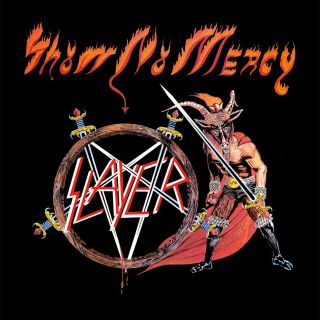
Painted by the band’s roadie’s dad, this all-important debut sleeve is a striking mishmash of the sublime and the ridiculous. The Slayer logo is given due prominence, this genre-defining visual stamp piercing the eye with iconic intensity. Then there’s the hairy-legged cartoon Baphomet in leather speedos.
“We were just kids, not having a lot of ideas of our own artistically,” Kerry admitted to Metal Hammer in 2015. “I remember showing [the artist] pictures of how we stand onstage to base that Baphomet creature on, to get the aggressive part of what we stood for. And that’s how it came out!”
Hell Awaits (1985)

Tom Araya told The Quietus that artist Albert Cuellar put together this sleeve “overnight”. Perhaps this frantic speed of turnaround is why the skeletal demon beasts fighting in the fiery pits of Hell bear a distinct resemblance to similar images in a 1977 issue of the comic Heavy Metal. No one seemed to notice until 2011, when excellently-titled blog Bang Your Head Or I’ll Rip It Off uploaded pdfs of the story Approaching Centauri, drawn by French artist Jean Giraud. Whatever the reason, Cuellar’s crafty treatment against a radiant infernal backdrop made for a definitive occult metal sleeve.
Reign In Blood (1986)

“We pretty much had grown up,” says Kerry King of this transitional third album sleeve, which brings Slayer art even further into Hell, down to its darkest, weirdest caverns. The twisted perspectives, elongated Xeroxed faces, queasy colouring and shadowy hanging figures – not to mention the goat servants’ erect penises – give Larry Carroll’s first Slayer sleeve a genuinely unsettling air. Not everyone appreciated its radical disorientation at first: “Nobody in the band wanted that cover,” Kerry King told Metal Hammer in 1987. “We were stuck with it. Some warped demented freak came up with the cover.”
South Of Heaven (1988)
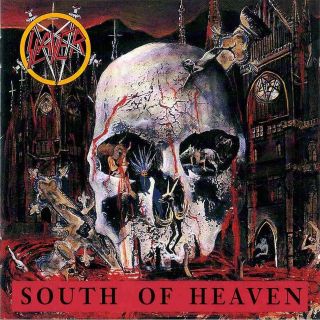
That warped demented freak’s second Slayer artwork didn’t quite sustain the distinctive dark disturbance of Reign In Blood, edging closer to ‘80s metal occult art cliche, and looking a little bit rushed – even though Larry Carroll was partnered on this project by illustrator Howard Schwarzberg (whose initials are scrawled on the bottom right). An enormous cracking skull, pierced by an inverted cross, welters in blood outside an enormous Satanic cathedral, as bizarre contorted animals frolic in the eye sockets. There’s some confusing horse accident in the right eye, but what’s going on in the left eye remains mind-boggling.
Seasons In The Abyss (1990)

Another huge skull, scarred with crosses, vomits smaller skulls and crosses into an inverted cross-shaped open grave, surrounded by skeletons hanging from stumps. It’s a pretty deranged image even by Larry Carroll’s standards, the thick black lines, harrowed eyes and chaotic, scratchy composition making it look like the nocturnal daubings of a homicidal maniac. This madness was simultaneously diminished and enhanced by Slayer’s Christmas card Seasons Greetings In The Abyss, on which the skull was given a Santa hat and beard, spewing giftwrapped pressies and candy canes into a grave shaped like a Christmas tree…
Divine Intervention (1994)
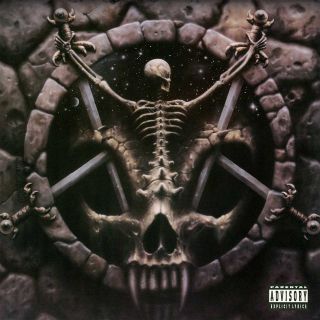
More bones, but a total change of approach for the band’s fifth album cover. This time Slayer’s traditional pentagram circle is rendered as a portal in a stone wall, through which materialises an impossible hybrid of a human skeleton and an alien wolf skull thing. New band artist Wes Benscoter melded a medieval sword-and-stone aesthetic with a touch of the cosmic, beautifully glimpsed in the starfield beyond. Benscoter’s compelling airbrushings have since graced releases by Black Sabbath, Dio, AC/DC, Autopsy, Bloodbath and Cattle Decapitation, as well as cult horror movie DVDs like Vampyros Lesbos and Demons.
Undisputed Attitude (1996)

You don’t hear much these days about Slayer’s odd, one-off punk rock covers album, and you never heard much about its rush-job artwork. Re-employing Wes Benscoter for a very different sort of image, a solarised photograph of rabid fans in the front row of a Slayer concert, this design came in for a drubbing by Joel McIver in his 2008 band biog The Bloody Reign Of Slayer: “The cursory artwork… added up to a lesser product than Slayer or their fans deserved,” Joel wrote, adding that the image “made fans worry that Slayer had lost their grip, or worse, their enthusiasm.”
Diabolus In Musica (1998)
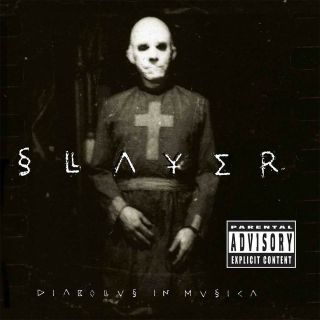
Thrash was a difficult age in the late ‘90s. Spiky logos and lurid artwork were out, sneeringly castigated as cheesy adolescent excesses from the previous decade. Each of the Big Four seemingly underwent a crisis of confidence, their original sound and vision retooled (or compromised) for the mainstream, which in 1998 had far more understated, arty-farty aesthetic tastes. Even Slayer replaced their timeless logo with small, quirky runic script, and chose a black-and-white, photographic sleeve for the first time. And although there is something oddly spooky about this bald, masked pseudo-priest figure, it’s not very Slayer.
God Hates Us All (2001)

Two sleeves exist for God Hates Us All; one is a dull geometric arrangement of gold crosses on a white background. It was designed to hide the other design, a generically controversial photo of a Bible with nails hammered into it, spattered with blood and branded with the Slayer logo. It all seemed a bit obvious and juvenile, as Kerry King himself later attested to Recoil Mag, asserting that the sleeve “looked like a seventh grader defaced the Bible” and was symptomatic of “a record company with absolutely no idea what the fuck they were going to do.”
Christ Illusion (2006)

With the return of original drummer Dave Lombardo, Slayer went all-out to reassert the memory of their late ‘80s Golden Era. And what better way to do so than with a bit of newly commissioned Larry Carroll art? Ideally something frightfully sacrilegious, featuring a tattooed amputee drug addict Jesus wading in a sea of blood, surrounded by the artist’s trademark warped photocopied imagery. By now, religious disapproval and controversy were Slayer’s aesthetic raison d’etre, and the sleeve necessitated another innocuous ‘alternate’ cover for certain outlets. Kerry liked this art so much he bought the original, painted on a 4’x4’ block of wood.
World Painted Blood (2009)

A rather more subtle, elegant, high-concept visual project courtesy of skateboard graphic whizz-kids Morning Breath Inc, the World Painted Blood artwork came with a slightly capitalistic caveat. To get the full effect of the titular design, you needed to buy four different versions of the album and piece the sleeves together to create one big map of the world, rendered in artful blood spray patterns and clusters of skulls and bones. Presumably it was a ruse to combat falling CD sales – and an artistically satisfying one as these things go – but the subsequent standard edition just looks all red and blotchy and indistinct.
Repentless (2015)
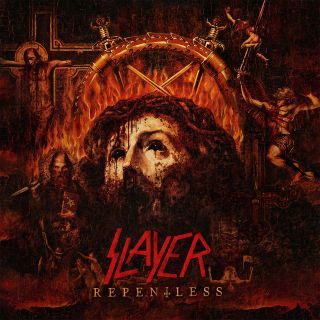
When Brazilian designer Marcelo Vasco was approached to put together another bloody, fiery image of irreligious disturbance for Slayer’s latest album, he was delighted: “I just wanted to make it look like one of the classic covers,” he admitted to metal art blog And Justice For Art, adding “There’s no point to be ‘new’ or try any different, modern or experimental shit. It’s boring!” There is something fractionally new here, though: last time we saw Jesus on a Slayer sleeve he looked like a strung-out sleazebag. Here, with his eyes full of bloody tears, he looks so harrowed we can’t help feeling sorry for the guy.
Slayer will headline this year’s Bloodstock festival on 14 August.


